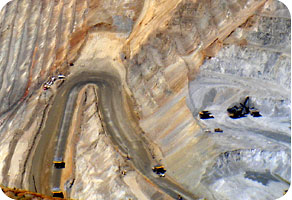Acid Mine Drainage Testing
Acid mine drainage refers to water contamination when pyrite (an iron sulfide) is exposed and reacts with air and water to form sulfuric acid and dissolved iron. This iron can precipitate to form red, orange, or yellow colored sediment in the bottom of streams containing mine drainage. The acid runoff also dissolves heavy metals such as copper, lead, and mercury, which may flow into ground water or surface water. Bacteria affects the rate in which the acid mine drainage may occur.

There are a number of major environmental problems caused by acid mine drainage. It disrupts growth and reproduction of aquatic plants and animals, diminishes valued recreational fish species, degrades outdoor recreation and tourism, contaminates surface and groundwater drinking supplies, and causes acid corrosion of infrastructure like wastewater pipes.
Testing & Analysis of Acid Mine Drainage
Analytical services are provided to the mining industry to help identify and treat sources of acid mine (or acid rock) drainage and the corresponding leaching of heavy metals into the environment. Our Tucson laboratory performs analyses of soil, waste rock, and spent ore for:
- Acid Generation Potential (Sulfur – total and forms)
- Neutralization Potential
- Net Acid Generation
- Heavy Metals Analyses
- Meteoric Water Mobility
- Humidity Cell Testing
- Column Leach and Attenuation Studies
- Effluent Treatability Studies
- General Agronomic Soil Tests